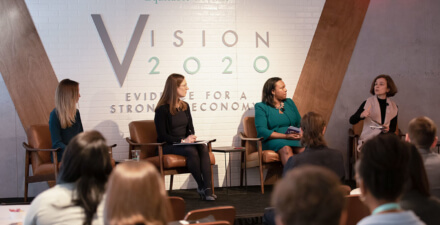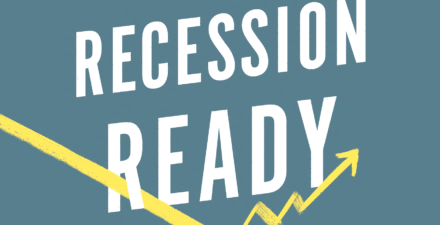Brad DeLong: Worthy reads on equitable growth, November 23–December 6, 2019
Worthy reads from Equitable Growth:
- If you haven’t read Heather Boushey’s new book, Unbound: How Inequality Constricts Our Economy and What We Can Do About It, then you should. She writes: “Do Americans really have to choose between equality and prosperity? … [Would] reducing economic inequality … require such heavy-handed interference with market forces that it would stifle economic growth[?] … Nothing could be further from the truth … Cutting-edge economics … shows how today’s inequality has become a drag on growth and an impediment to free market efficiency … [There are] deep problems in the U.S. economy, but … policymakers can preserve the best of our economic and political traditions, and improve on them.”
- Solvency crises, not liquidity crises, underpin the substantial bulk of Americans’ financial distress experiences. Read Will Dobbie and Jae Song, “Targeted Debt Relief and the Origins of Financial Distress: Experimental Evidence from Distressed Credit Card Borrowers,” in which they write: “We study the drivers of financial distress using a large-scale field experiment that offered randomly selected borrowers a combination of (i) immediate payment reductions to target short-run liquidity constraints and (ii) delayed interest write-downs to target long-run debt constraints. We identify the separate effects of the payment reductions and interest write-downs using both the experiment and cross-sectional variation in treatment intensity. We find that the interest write-downs significantly improved both financial and labor market outcomes, despite not taking effect for three to five years. In sharp contrast, there were no positive effects of the more immediate payment reductions. These results run counter to the widespread view that financial distress is largely the result of short-run constraints.”
- Here at Equitable Growth we now have a macroeconomics director! Listen to Claudia Sahm on Bloomberg Radio at 3 p.m. today.
Worthy reads not from Equitable Growth:
- In a world riddled by frequent and deep business-cycle recessions, work requirements for safety-net programs are a really bad idea. Read Hilary Hoynes and Diane Whitmore Schanzenbach, “Strengthening SNAP as an Automatic Stabilizer,” in which they write: “The Supplemental Nutrition Assistance Program (SNAP) is a universal program with eligibility criteria based on household income, allowing it to expand automatically when the economy contracts and vice versa. Unfortunately, this stabilization feature is often limited by work requirements for SNAP eligibility, which restrict benefits for some workers who lose their jobs or otherwise experience labor market volatility during recessions … Two reforms [would] strengthen SNAP as an automatic stabilizer. First … either limiting SNAP work requirements—by automatically removing work requirements during downturns—or eliminating work requirements altogether. Second … an automatic 15 percent increase in SNAP benefits during recessions.”
- It is a great pity that Steve Greenhouse’s generation of labor reporters at major media institutions was the last. When they retired, the slots were cut. Read Zephyr Teachout, “Review of Steven Greenhouse: The Upheaval in the American Workplaces,” in which she writes: “There’s an enormous upheaval in the American workplace right now … Beaten Down, Worked Up [is] the engrossing, character-driven, panoramic new book on the past and present of worker organizing by the former New York Times labor reporter Steven Greenhouse. At the beginning of this decade, less than 7 percent of private-sector workers belonged to a union, and support for organized labor unions was at an all-time low. Corporations were using illegal tactics to stop unionization, tactics unheard-of in other countries, and new hires at the biggest companies were often required to watch anti-labor propaganda depicting unions as greedy and self-interested … The “Fight for $15” was born, leading to huge rallies and predawn fast-food walkouts across the country. The workers lacked union protection, and big corporations shelled out cash telling lawmakers that raising the wage would cause small businesses to collapse and result in economic disaster. Nonetheless, the workers won. A wave of minimum wage raises passed. In New York, the rate hit the magic number of $15 an hour. Those 2012 meetings and the Fight for $15 almost didn’t happen; this was not the kind of organizing work that labor unions like S.E.I.U. had been doing for decades. This required unions to spend money on organizing people who would most likely never pay dues. You’ll have to read Greenhouse’s book to learn why the union did it, and how a $50 million failure by one of the country’s biggest unions led to one of its greatest recent successes.”
- I was surprised to find, in some circles, a strange lack of enthusiasm for the Banerjee-Duflo-Kremer Economics Nobel Prize. Here is some necessary and important pushback against this lack of enthusiasm. Read Oriana Bandiera, “Alleviating Poverty with Experimental Research: The 2019 Nobel Laureates,” in which she writes: “The 2019 Nobel Prize in Economic Sciences has been jointly awarded to Abhijit Banerjee, Esther Duflo, and Michael Kremer “for their experimental approach to alleviating global poverty.” This column discusses the new laureates’ vision and their common interest in both understanding and addressing the persistence of poverty and the huge differences in living standards across countries … Development economics had no Ph.D. courses, no group at the NBER or CEPR, and hardly any publications in top journals until the early 2000s. What this year’s Nobel laureates did was to build the infrastructure to make fieldwork widely accessible and the methods to make the analysis credible. What they did, and what they were awarded for, is to put development economics back on center stage. The prize to Abhijit Banerjee, Esther Duflo, and Michael Kremer is unusual in many ways. Passionate about statistical trivia, the economist on the street will quickly point out that the three are very young, that Esther Duflo is only the second woman to win it, and that she is the youngest ever economics laureate. This is indeed unusual—but it is largely irrelevant. What is unusual and relevant is that the nomination explicitly mentions that the winners lead a group effort.”
- What the researchers call, I think somewhat unfortunately, “non-cognitive routine” work is a puzzle for us as we try to look into the future. We used to know what this very large and very important category of jobs was: staple crop farming, or simple craftwork, and later factory work on an assembly line or moving items or boxes in a distribution channel. There still is a lot of this work in distribution channels and in construction, but we can foresee this category of employment shrinking rapidly in the next generation, and we are having a hard time imagining what other jobs in this category will rise. Read Beth Gutelius and Nik Theodore, “The Future of Warehouse Work: Technological Change in the U.S. Logistics Industry,” in which they write: “Are “dark” warehouses, humming along without humans, just around the corner? Predictions of dramatic job loss due to technology adoption and automation often highlight warehousing as an industry on the brink of transformation … We project that the industry likely won’t experience dramatic job loss over the next decade, though many workers may see the content and quality of their jobs shift as technologies are adopted for particular tasks. Employers may use technology in ways that decrease the skill requirements of jobs in order to reduce training times and turnover costs. This could create adverse effects on workers, such as wage stagnation and job insecurity. New technologies potentially can curtail monotonous or physically strenuous activities, but depending on how they are implemented, may present new challenges for worker health and safety, employee morale, and turnover. Additionally, electronically mediated forms of monitoring and micro-management threaten to constrain workers’ autonomy and introduce new rigidities into the workplace.”







